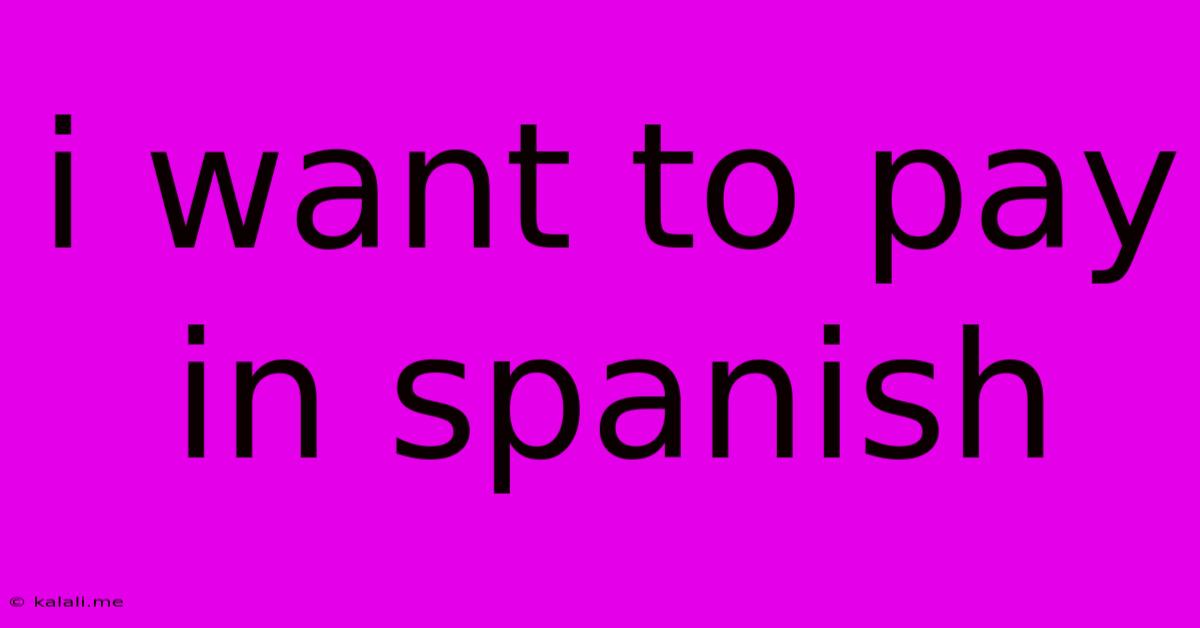I Want To Pay In Spanish
Kalali
May 22, 2025 · 3 min read

Table of Contents
I Want to Pay in Spanish: A Comprehensive Guide to Mastering Payment Phrases
Paying for goods and services in Spanish can seem daunting at first, but mastering a few key phrases will make your transactions smoother and more confident. This guide provides a comprehensive overview of how to say "I want to pay" in Spanish, along with essential vocabulary for various payment methods and situations. This will help you navigate transactions in Spanish-speaking countries with ease, whether you're haggling at a market or checking out at a large department store.
This article will cover everything you need to know about expressing payment intentions in Spanish, including variations based on context, polite phrasing, and helpful phrases for clarifying payment methods. Let's dive in!
Common Ways to Say "I Want to Pay" in Spanish
The most straightforward way to say "I want to pay" in Spanish is "Quiero pagar." This is perfectly acceptable in most situations. However, depending on the context, you might use slightly different phrasing for better nuance and politeness. Here are a few alternatives:
- "Voy a pagar." (I'm going to pay.) This implies a more immediate intention to pay.
- "¿Cuánto es?" (How much is it?) This is a common way to initiate the payment process, showing your readiness to pay after confirming the price.
- "La cuenta, por favor." (The bill, please.) This is more suitable for restaurants or bars.
- "Necesito pagar." (I need to pay.) A slightly more formal way of expressing your intention.
Remember that the best phrase will often depend on the situation. Being polite and using appropriate language is crucial in any Spanish-speaking culture.
Specifying Your Payment Method
Once you've indicated your desire to pay, you'll need to specify your preferred method. Here's how to do it in Spanish:
- "Pago con tarjeta de crédito/débito." (I'll pay with credit/debit card.) This is a common and widely accepted payment method.
- "Pago en efectivo." (I'll pay in cash.) Always useful to know, especially in smaller establishments.
- "Pago con PayPal/Apple Pay/Google Pay." (I'll pay with PayPal/Apple Pay/Google Pay.) Digital payment methods are becoming increasingly popular.
- "¿Aceptan tarjetas?" (Do you accept cards?) This is a helpful question to ask before you start the transaction.
- "¿Puedo pagar con...?" (Can I pay with...?) A polite way to inquire about specific payment options.
Handling Potential Issues
Sometimes, unexpected issues can arise during a transaction. Here are some useful phrases to help you navigate these situations:
- "No funciona mi tarjeta." (My card isn't working.)
- "¿Hay algún problema con mi pago?" (Is there a problem with my payment?)
- "Perdón, no entiendo." (Excuse me, I don't understand.)
- "¿Puede repetir, por favor?" (Can you repeat that, please?)
Beyond the Basics: Adding Politeness and Nuance
Adding phrases like "por favor" (please) and "gracias" (thank you) will significantly enhance your interactions. Remember to maintain a polite and respectful tone throughout the transaction.
Conclusion
Mastering payment phrases in Spanish is a valuable skill for anyone traveling or interacting with Spanish speakers. By learning the different ways to say "I want to pay," specifying your payment method, and knowing how to handle potential issues, you can confidently navigate transactions and enhance your overall experience. Remember to practice these phrases in context to build fluency and confidence in your Spanish communication skills. So, go ahead and confidently say, "Quiero pagar!"
Latest Posts
Latest Posts
-
The Man In The High Castle Map World
May 22, 2025
-
A Substance That Evaporates At Room Temperature Is Described As
May 22, 2025
-
Why Is My Hamster Gnawing The Cage
May 22, 2025
-
Why Sodium Chloride Does Not Conduct Electricity
May 22, 2025
-
Can You Use Led Light Bulbs With A Dimmer Switch
May 22, 2025
Related Post
Thank you for visiting our website which covers about I Want To Pay In Spanish . We hope the information provided has been useful to you. Feel free to contact us if you have any questions or need further assistance. See you next time and don't miss to bookmark.